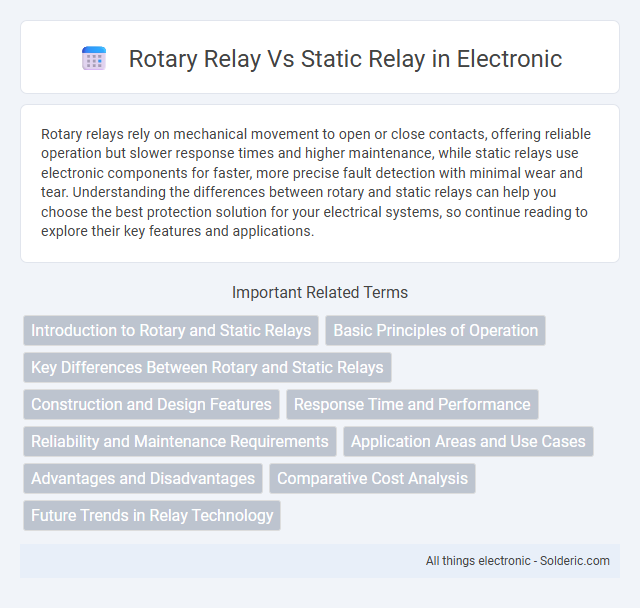Rotary relays rely on mechanical movement to open or close contacts, offering reliable operation but slower response times and higher maintenance, while static relays use electronic components for faster, more precise fault detection with minimal wear and tear. Understanding the differences between rotary and static relays can help you choose the best protection solution for your electrical systems, so continue reading to explore their key features and applications.
Comparison Table
| Feature | Rotary Relay | Static Relay |
|---|---|---|
| Operating Principle | Electromechanical rotating element | Electronic circuits without moving parts |
| Response Time | Slow (milliseconds to seconds) | Fast (microseconds to milliseconds) |
| Reliability | Lower due to mechanical wear | Higher, solid-state components |
| Maintenance | Requires regular mechanical servicing | Minimal maintenance needed |
| Accuracy | Moderate | High precision |
| Size & Weight | Bulky and heavy | Compact and lightweight |
| Power Consumption | Higher due to coil operation | Lower power usage |
| Cost | Lower initial cost | Higher initial investment |
| Applications | Older electrical protection systems | Modern protection systems, automation |
Introduction to Rotary and Static Relays
Rotary relays utilize electromechanical components to open or close contacts through physical movement, making them reliable for traditional protection systems. Static relays employ electronic circuits with no moving parts, offering faster response times and improved accuracy in modern power systems. Both relay types are essential for electrical protection, with rotary relays favored for simpler, lower-speed applications and static relays dominating in high-precision, rapid fault detection environments.
Basic Principles of Operation
Rotary relays operate using electromagnetic principles, where a rotating armature physically opens or closes contacts in response to current flow, providing mechanical switching. Static relays, in contrast, use solid-state electronic components like transistors and diodes to perform switching functions without moving parts, resulting in faster and more reliable response times. Your choice between rotary and static relays depends on the application's need for durability, speed, and precision in electrical protection systems.
Key Differences Between Rotary and Static Relays
Rotary relays operate using electromagnetic components to create mechanical movement, whereas static relays rely on solid-state electronics without moving parts. Rotary relays typically feature slower response times and physical wear, while static relays offer faster operation and greater reliability due to their electronic circuitry. Understanding these key differences helps you select the appropriate relay type for high-speed, maintenance-sensitive applications or traditional setups.
Construction and Design Features
Rotary relays feature electromagnetic coils and mechanical moving parts such as armatures and contacts, providing physical movement to open or close circuits, resulting in a robust but relatively slower response time. Static relays rely on solid-state components like transistors, diodes, and integrated circuits, eliminating moving parts and offering faster, more reliable operation with minimal maintenance requirements. Your choice between rotary and static relay designs depends on application needs for durability, speed, and precision in protective switching systems.
Response Time and Performance
Rotary relays typically have slower response times due to mechanical components that require movement, ranging from tens to hundreds of milliseconds, while static relays offer faster response times generally within a few milliseconds due to solid-state electronic circuits. Static relays provide higher accuracy and reliability in performance since they are less affected by mechanical wear and environmental factors compared to rotary relays. The improved speed and consistency of static relays make them preferable for modern protective relay applications requiring precise and rapid fault detection.
Reliability and Maintenance Requirements
Rotary relays, composed of mechanical moving parts, typically require regular maintenance to ensure reliable operation, as wear and tear can affect their performance over time. Static relays, using electronic components with no moving parts, offer higher reliability and lower maintenance needs, reducing downtime and operational costs. Choosing static relays can enhance your system's reliability while minimizing the need for frequent inspections and repairs.
Application Areas and Use Cases
Rotary relays are commonly used in legacy industrial systems, electrical protection schemes, and older telecommunication equipment where mechanical reliability and simplicity are paramount. Static relays find extensive application in modern power systems, automation controls, and advanced protective relaying due to their fast response time, high accuracy, and ease of integration with digital controls. Power plants, substations, and manufacturing automation widely prefer static relays for precise fault detection and system monitoring, while rotary relays remain in use for cost-effective, robust solutions in less complex environments.
Advantages and Disadvantages
Rotary relays offer mechanical simplicity and high reliability under specific operating conditions, with advantages such as easy maintenance and clear visual indication of contact positions, but they suffer from slower response times and mechanical wear over prolonged use. Static relays provide faster operation, greater accuracy, and improved durability due to the absence of moving parts, though they can be more complex to design and may require more sensitive electronic components susceptible to electrical noise. Choosing between rotary and static relays depends on factors like operational speed requirements, environmental conditions, maintenance capabilities, and desired lifespan.
Comparative Cost Analysis
Rotary relays generally have higher initial purchase and maintenance costs due to their mechanical components and moving parts, which are prone to wear and require regular servicing. Static relays, utilizing solid-state electronics, tend to offer lower long-term operating expenses and increased reliability, reducing downtime and maintenance expenditures. Cost-effectiveness of static relays is especially evident in large-scale or critical industrial applications due to their enhanced precision and longevity.
Future Trends in Relay Technology
Future trends in relay technology highlight a shift from rotary relays, known for their mechanical components and slower response times, towards static relays that leverage solid-state electronics for faster operation and enhanced reliability. Innovations in microprocessor-based protection systems integrate advanced algorithms and digital communication protocols, enabling more accurate fault detection and adaptive protection schemes. The ongoing development of IoT-enabled relays and machine learning applications promises to revolutionize predictive maintenance and real-time grid management.
rotary relay vs static relay Infographic

 solderic.com
solderic.com